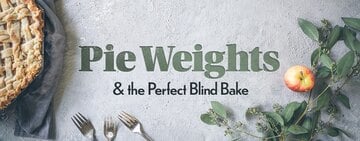How To Choose the Right Vanilla
Vanilla is one of the most prized and widely used flavors in any bakery or commercial kitchen. But where does it come from, and what types of vanilla are the best to use? We've provided a vanilla guide to help you choose the right vanilla for your recipe.
Shop All Vanilla ExtractsWhere Does Vanilla Flavoring Come From?

Vanilla flavoring comes from vanilla orchids. These vanilla flowers are grown in different regions, and each type of orchid produces a vanilla bean with unique characteristics. Below are four of the most commonly used vanilla beans:
- Madagascar Vanilla Beans - Madagascar vanilla beans, also called Bourbon vanilla beans, are the most popular type of bean in the world and have a strong, creamy flavor.
- Mexican Vanilla Beans - Mexican vanilla beans are considered some of the best beans in the world, and they have a smooth, smoky vanilla flavor with a hint of spice.
- Tahitian Vanilla Beans - Tahitian vanilla beans have a unique floral flavor with notes of cherry and licorice. Among the most expensive types of vanilla, Tahitian beans are almost twice the size of other vanilla beans.
- Ugandan Vanilla Beans - Ugandan vanilla beans are not as well known, but they contain high amounts of natural vanillin, which gives them a bold flavor and aroma.
What Is Vanilla?
Vanilla flavor comes from the dried seed pod of the vanilla orchid. Harvesting vanilla seed pods is a delicate, labor-intensive process that begins with the hand-pollination of the flower. Once pollinated, the flower produces a cluster of long, green bean pods. It takes several months for the pods to mature and even longer for the drying process to be complete. The fully matured, dried pod is what many would recognize as a dark-brown vanilla bean.
What Is Vanillin?
Vanillin is the name of a naturally occurring organic compound that contributes to the flavor of vanilla beans. Mostly when the term vanillin is used, it refers to the synthetic version of the flavor compound. Manufacturers discovered they could create an artificial version of vanilla flavor by synthesizing the vanillin compound in a lab.
Imitation Vanilla vs Vanilla Extract
Pure vanilla extract contains natural vanillin, and imitation vanilla is made from synthetic vanillin. Natural vanilla flavor also contains hundreds of flavor compounds besides vanillin, but imitation vanilla flavoring gets its flavor from vanillin alone. This explains why natural vanilla has a more complex flavor and why artificial vanilla may lack depth.
But don't count out imitation vanilla as a flavor enhancer! There are some baking applications where you'll want to reach for imitation vanilla instead of the pure extract. Keep reading to learn more!
Types of Vanilla Products
Many recipes just aren't complete without vanilla flavoring. If you’ve ever wondered which type of vanilla product you should use, check out our guide below:
1. Vanilla Bean

Vanilla beans are the most expensive form of vanilla flavor, which is why many bakers end up using the more affordable extracts or flavorings. Splurging on real vanilla beans can elevate your desserts to a new level, not just by adding depth of flavor, but also by adding appealing flecks of brown from the vanilla seeds. Most fans of vanilla know when they see vanilla bean seeds in a product, it indicates a higher quality. Use vanilla beans when you want to create a show-stopping dessert for a special occasion.
To use vanilla bean, cut the ends off the bean pod and split it lengthwise to reveal thousands of tiny brown seeds bursting with vanilla flavor. Scrape out the seeds and add them to ice cream, custards, or light-colored buttercreams that show off the brown seeds. Keep in mind that high temperatures can break down all the complex flavors of vanilla bean seeds, so save this special ingredient for uncooked or lightly simmered items.
- Vanilla Bean Form - Small, dark brown seeds and pulp
- Vanilla Bean Flavor - Highly concentrated, complex vanilla flavor
- Best Uses for Vanilla Bean - Artisan-quality desserts, delicate items cooked with low heat, homemade vanilla extract
- Vanilla Bean Substitutes - Use 1 Tbsp. of vanilla extract or 1 Tbsp. of vanilla bean paste in place of 1 vanilla bean
2. Vanilla Bean Paste

Vanilla bean paste is made from the scraped seeds of a vanilla bean suspended in a thick extract. Next to the real vanilla bean, vanilla paste contains the most concentrated flavor. It also provides the same visual effect as a vanilla bean, with flecks of brown seeds appearing throughout your batters or custards.
The benefits of vanilla bean paste are that it provides a strong flavor and contains actual seeds but doesn't require the same preparation as the bean. It's more affordable than vanilla beans and more concentrated than vanilla extract, making it a happy medium between the two. Vanilla bean paste also contains less liquid than vanilla extracts, so it won't water down your recipes.
- Vanilla Bean Paste Form - Thick, jelly-like paste with flecks of brown seeds
- Vanilla Bean Paste Flavor - Rich, smooth vanilla flavor
- Best Uses for Vanilla Bean Paste - Puddings, custards, ice cream, light-colored cakes or frostings
- Vanilla Bean Paste Substitutes - Use 1 Tbsp. of vanilla extract or 1 vanilla bean for every 1 Tbsp. of vanilla bean paste
3. Pure Vanilla Extract

Pure vanilla extract is made by soaking ground vanilla beans in a solution of alcohol and water. For the product to be labeled “pure”, it must contain 13.35% vanilla bean solids and 35% alcohol. Some vanilla extract products contain sugar or corn syrup to enhance the flavor of low-quality vanilla beans. Look for pure vanilla extract that contains only vanilla bean, alcohol, and water for a better quality product that will become more complex with age.
Because vanilla extract is more affordable than vanilla beans or vanilla paste, it’s useful in high-volume baking applications. Its thin liquid form can also be blended more evenly throughout cookie dough and cake batters to provide consistent flavor. When baking dark-colored treats like brownies, vanilla extract is the logical choice. Vanilla bean seeds will not be visible in these products, so it doesn’t make sense to splurge on beans or paste.
- Pure Vanilla Extract Form - Thin, brown liquid
- Pure Vanilla Extract Flavor - Smooth, mellow vanilla flavor
- Best Uses for Pure Vanilla Extract - Cookies, brownies, cakes, muffins, frostings, sauces
- Pure Vanilla Extract Substitutes - Use 1 Tbsp. of vanilla bean paste or 1 vanilla bean for every 1 Tbsp. of vanilla extract
4. Imitation Vanilla

Imitation vanilla is made from synthetic vanillin, one of the flavor compounds that gives natural vanilla its flavor. Because artificial vanilla only contains one flavor compound, it lacks the complex, nuanced flavors of real vanilla. However, imitation vanilla does have some benefits in the kitchen.
Vanilla beans, paste, and extracts have more depth of flavor than imitation vanilla, but many of those flavor notes break down at the high temperatures used during baking. For this reason, imitation vanilla is preferred by some bakers for cookies and cakes. Strong vanilla flavor comes through after baking and usually cannot be distinguished from the real thing.
- Imitation Vanilla Form - Thin liquid, may be brown or clear
- Imitation Vanilla Flavor - Slightly bitter out of the bottle, strong one-note vanilla flavor in baked goods
- Best Uses for Imitation Vanilla - Cookies and cakes
- Imitation Vanilla Substitutes - Use 1 Tbsp. of vanilla extract for every 2 Tbsp. of imitation vanilla
5. Vanilla Powder

Vanilla powder is made from dried, ground vanilla beans. The pure form of vanilla powder contains no fillers and should be light brown to dark brown in color. If the vanilla powder is white, it contains sugar or maltodextrin and has different uses. For rich, concentrated vanilla flavor, look for pure vanilla powder.
Because vanilla powder contains no liquids, it can be added to buttercreams or batters without watering down the recipe. It also has an intense flavor that doesn’t diminish or burn off at high temperatures. The downside of vanilla powder? It’s just as expensive as vanilla beans.
- Vanilla Powder Form - Dry, brown powder
- Vanilla Powder Flavor - Rich, complex vanilla flavor
- Best Uses for Vanilla Powder - Desserts that require a balanced ratio of liquid and dry ingredients, baked goods cooked at high temperatures, dry mixes
- Vanilla Powder Substitutes - 1/2 tsp. of vanilla powder is equal to 1 tsp. of vanilla extract, 1 tsp. of vanilla paste, or a 2" section of vanilla bean
6. Vanilla Syrup

Vanilla syrup is a thick, sweet liquid made from sugar, water, and vanilla extract. Use vanilla flavoring syrup to sweeten beverages and desserts and add a touch of vanilla flavor. Most vanilla syrups are packaged in large bottles with a pump dispenser that makes it easy to add syrup to coffee drinks and cocktails.
Not suited for baking applications, vanilla syrup is the best product to use for cocktails, smoothies, and signature coffee drinks. The sweet syrup dissolves easily in beverages and can be combined with other syrups to create unique flavor combinations.
- Vanilla Syrup Form - Thick, syrup-like liquid
- Vanilla Syrup Flavor - Sugary with sweet vanilla flavor
- Best Uses for Vanilla Syrup - Smoothies, cocktails, coffee drinks, flavored sodas, egg creams
- Vanilla Syrup Substitutes - Add 3 tsp. of vanilla extract to 1 cup of simple syrup to make your own vanilla syrup
Vanilla Flavor FAQs

We answer some common questions about vanilla flavoring:
Is Vanilla a Fruit?
Yes, vanilla beans are the edible fruit of a flowering orchid. Real vanilla flavor comes from the cured bean pods of the vanilla orchid.
Does Vanilla Come From Beavers?
The vanilla extract in your baking products and extracts most likely does not come from beavers. It's possible to source a vanilla flavor compound (castoreum) from beaver castor sacs, but this is a costly, labor-intensive process. If you want to be sure that you aren't using castoreum, check the ingredients on your vanilla products. You are in the clear if you see vanilla beans, vanilla extracts, or artificial flavor (synthetic vanillin) listed.
Where Do Vanilla Beans Come From?
Most of the vanilla beans sold commercially are harvested from vanilla orchids grown in Madagascar, Mexico, and Tahiti. There are vanilla orchids grown in other regions, but they are not as widely distributed.
How Much Imitation Vanilla Equals Vanilla Extract?
For most products, it takes twice as much imitation vanilla to equal vanilla extract. Use 2 tsp. of imitation vanilla in place of 1 tsp. of vanilla extract.
How Long Does Vanilla Last?
Pure vanilla extract with no additives will last indefinitely if it is stored in a cool, dark place. It will even develop more complex flavors over time. Imitation vanilla may start to lose its potency after 4 years.
Is Vanilla Extract Alcoholic?
Yes, pure vanilla extract contains at least 35% alcohol. Most of the alcohol burns off in the baking process and cannot be detected in the finished product. If you prefer to use an alcohol-free product, substitute 2" of a vanilla bean or 1/2 tsp. of vanilla bean powder for 1 tsp. of pure vanilla extract.
Each vanilla product has advantages that make it useful in different applications. Vanilla beans are expensive but may be the gourmet ingredient you need to create delicate custards and luscious creams. Vanilla extract is an all-around, versatile ingredient that many bakers keep on hand for their recipes. But don't count out imitation vanilla! It's affordable and actually adds more flavor to baked goods cooked at high temperatures.



